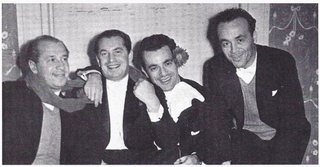Timeline

The Pro Arte String Quartet is a string quartet founded in Belgium, which became affiliated with the University of Wisconsin-Madison in 1941.
The Pro Arte String Quartet was founded by Alphonse Onnou in Brussels in 1912. [1] After becoming the Court Quartet to Queen Elizabeth of Belgium, the quartet began the first of many international tours in 1919. After the First World War it became famous for the performance of modern music and for its extensive recordings of Haydn. The composers Bartók, Milhaud and Honegger entrusted to the ensemble new works to premiere. The Pro Arte Quartet made its American debut in 1926 in New York and returned for 30 tours to the United States, often under the auspices of the chamber music patron Elizabeth Sprague Coolidge. It performed at the inauguration of the Hall of Music at the Library of Congress in Washington, DC. In 1932 it was named the "Quatuor de la Cour de Belgique". Its first visit to Madison, Wisconsin was in 1938. Two years later, the musicians were stranded in Madison by the outbreak of World War II and accepted a residency at the University of Wisconsin–Madison, the first such residency at a major American university.
The Royal Conservatory of Brussels holds a comprehensive collection of autograph and printed Second Violin scores from Laurent Halleux, who joined the Pro Arte Quartet when he was only fifteen and stayed with the group till 1943. It sheds light on the works performed by the quartet, especially from American composers from the early XXe s. such as Aaron Copland, Roy Harris or Louis Gruenberg.
While touring in Wisconsin in 1941[ inconsistent ] they were offered a permanent residency. In 1944, following the disbanding of the Kolisch Quartet, Rudolf Kolisch took up leadership of the Pro Arte in 1944, combined with a Wisconsin Professorship. In 1946, Robert Maas became the original cellist in the newly formed Paganini Quartet. In 1947, violist Germain Prevost, the last of the original members, resigned. In the late 1950s, the Pro Arte Quartet became members of the University's School of Music faculty in addition to being artists-in-residence. [2]
The Pro Arte Quartet reached its centennial anniversary in 2012. To honor this occasion, the quartet embarked on a commissioning project to include up to eight new works, presented throughout the 2011-2012 season.
The original personnel of the Pro Arte Quartet were:
1st violin: Alphonse Onnou
2nd violin: Laurent Halleux
viola: Germain Prévost
violoncello: Fernand-Auguste Lemaire
The current personnel are:
1st violin: David Perry
2nd violin: Suzanne Beia
viola: Sally Chisholm
violoncello: Parry Karp

(78rpm recordings (Victor/HMV) of the original Pro Arte up to 1936:- )
The Haydn Quartet Society was formed in 1932 by HMV and by 1936 the Pro Arte recorded five volumes of records available only as complete sets. The contents were:

Artur Schnabel was an Austrian-American classical pianist, composer and pedagogue. Schnabel was known for his intellectual seriousness as a musician, avoiding pure technical bravura. Among the 20th century's most respected and important pianists, his playing displayed marked vitality, profundity and spirituality in the Austro-German classics, particularly the works of Beethoven and Schubert.

A string quintet is a musical composition for five string players. As an extension to the string quartet, a string quintet includes a fifth string instrument, usually a second viola or a second cello, or occasionally a double bass.
The Melos Quartet was a much-recorded, Stuttgart-based string quartet active from 1965 until 2005, when its first violin died. It also went by the name Melos Quartett Stuttgart, partly to distinguish itself from the equally prominent chamber group the Melos Ensemble of London.

The Budapest String Quartet was a string quartet in existence from 1917 to 1967. It originally consisted of three Hungarians and a Dutchman; at the end, the quartet consisted of four Russians. A number of recordings were made for HMV/Victor through 1938; from 1940 through 1967 it recorded for Columbia Records. Additionally, several of the Quartet's live performances were recorded, at the Library of Congress and other venues.

The Paganini Quartet was an American virtuoso string quartet founded by its first violinist, Henri Temianka, in 1946. The quartet drew its name from the fact that all four of its instruments, made by Antonio Stradivari (1644–1737), had once been owned by the great Italian violinist and composer Niccolo Paganini (1782–1840).

A major is a major scale based on A, with the pitches A, B, C♯, D, E, F♯, and G♯. Its key signature has three sharps. Its relative minor is F-sharp minor and its parallel minor is A minor. The key of A major is the only key where a Neapolitan sixth chord on requires both a flat and a natural accidental.

F major is a major scale based on F, with the pitches F, G, A, B♭, C, D, and E. Its key signature has one flat: B♭. Its relative minor is D minor and its parallel minor is F minor.

In music theory, B-flat major is a major scale based on B♭, with pitches B♭, C, D, E♭, F, G, and A. Its key signature has two flats. Its relative minor is G minor and its parallel minor is B-flat minor.

E-flat major is a major scale based on E♭, with the pitches E♭, F, G, A♭, B♭, C, and D. Its key signature has three flats: B, E, and A. Its relative minor is C minor, while its parallel minor is E♭ minor.
Lillian Fuchs was an American violist, teacher and composer. She is considered to be among the finest instrumentalists of her time. She came from a musical family, and her brothers, Joseph Fuchs, a violinist, and Harry Fuchs, a cellist, performed with her on various recordings.

The Flonzaley Quartet was a string quartet organized in Manhattan, New York City in 1902. The group disbanded in 1929.
The Léner String Quartet, sometimes written the Lehner String Quartet, was a string quartet of Hungarian origin, founded in Budapest in 1918, which for most of its pre-war career operated in or from London. They appeared at the Royal Albert Hall, London on three occasions between 1922 and 1926. They also performed in New York, Amsterdam, and elsewhere in Europe. The Léner made the first complete recorded cycle of Beethoven quartets.
The Spencer Dyke Quartet was a string quartet active in England through the 1920s. It is best remembered now for a series of pioneering chamber music recordings made for the National Gramophonic Society.

Alfred Charles Hobday was an English viola player who made his career in England. He was the elder brother of the double-bass player Claude Hobday.
Claude Hobday was an English double-bass player, a member of a well-known musical family, who took part in various early chamber-music recordings.
Leonard Hokanson was an American pianist who achieved prominence in Europe as a soloist and chamber musician. Born in Vinalhaven, Maine, he attended Clark University in Worcester, Massachusetts and Bennington College in Vermont, where he received a master of arts degree with a major in music. He made his concert debut with the Philadelphia Orchestra at the age of eighteen. Drafted into the U.S. Army after graduate school, he was posted to Augsburg, Germany. He achieved early recognition as a performer in Europe, serving as a soloist with such orchestras as the Berlin Philharmonic, the Rotterdam Philharmonic, and the Vienna Symphony. He was awarded the Steinway Prize of Boston and was a prizewinner at the Busoni International Piano Competition in Bolzano, Italy. His numerous international music festival appearances included Aldeburgh, Berlin, Echternach, Lucerne, Prague, Ravinia, Salzburg, Schleswig-Holstein, Tanglewood, and Vienna.

The Pražák Quartet is a Czech string quartet established in 1972. It is one of the Czech Republic's premiere chamber ensembles. It was founded while its members were still students at Prague Conservatory (1974–1978). The quartet was awarded First Prize at the Evian International Competition in 1978 and the Prague Spring Festival Prize in 1979 with second places not being awarded at both the competitions to indicate the difference in level.
The Laurent Halleux collection is the donation, to the library of the Royal Conservatory of Brussels, of printed scores and manuscripts from the Belgian violinist Laurent Halleux (1897–1964), by his daughter, Suzanne Keller-Halleux.